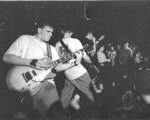Archives & Special Collections
 Please Respond Personally: Commemorating the 1974 Black Student Sit-In
Please Respond Personally: Commemorating the 1974 Black Student Sit-In
Richard Schimmelpfeng Gallery
Dodd Center for Human Rights
Monday - Friday, 9am to 4pm
through December 13, 2024
The exhibit commemorates the direct action taken by Black and Brown students on the Storrs campus to challenge structural racism in higher education by sitting in at the Wilbur Cross Library on April 22nd 1974. This historic event of activism, where roughly 370 students occupied the library at varying times across 3 days, was the culminating event during a semester long campaign of student organizing to demand representation and resources for students of color at the University of Connecticut. Through curated documents this exhibition will feature the perspectives of the student organizers, the Afro-American Cultural Center, the University and its administration to portray this campus-wide call to action which resonates to our present day. This 50th anniversary is also an opportunity to highlight approaches to student activism and the centrality of the library as an institutional setting both for democracy and also one vulnerable to upholding systems of oppression.
This exhibition draws from the experiences of alumni Rodney Bass (’75BA/’76MA) who read the demands during the sit-in and was co-chair of the Organization of African American Students (OAAS). The archives podcast d’Archive produced an interview with Rodney about Black student organizing in the mid-1970s on the Storrs campus which is revealing in understanding their approach to making demands upon the university for their representation in the student body.
Homer Babbidge Library
 Live at the Anthrax
Live at the Anthrax
photography from the Joe Snow Punk Rock Collection
Gallery on the Plaza
Homer Babbidge Library
On display through March 23, 2025
The UConn Archives presents Live at the Anthrax, an exhibition of performance photography from the Joe Snow Punk Rock Collection. Joe photographed the thriving Connecticut Hardcore Punk Rock (CTHC) scene in the late 1980s during the final years of the Anthrax club in Norwalk. Bands featured in the selection include local CTHC staples such as Wide Awake and NY Hardcore bands Up Front and Absolution to seminal acts such as Fugazi. This curated exhibition highlights the dedication, energy and lived values of those who formed the hardcore scene and turned it into a community.
 Picturing the Pandemic – Pandemic Journaling Project
Picturing the Pandemic – Pandemic Journaling Project
Five Years.
A Community Commemoration
Plaza Entrance
Homer Babbidge Library
on display from March 5-21, 2025
Opening Reception - Thursday, March 6, 4-5:30pm
What does a pandemic look like? What has COVID-19 helped us, or made us, see? How has it changed our sense of what counts as true—or whose truth counts?
It’s hard to believe it’s been five years since COVID-19 appeared on the scene, convulsing the world as we knew it. While our attention may be trained on other disasters at the moment, we think it's important to mark this sober milestone by taking take stock of where we were, and where we are now.
This innovative exhibition explores how people around the globe use images to tell their own pandemic stories—and to question and critique our changing world. At once joyful and devastating, funny, and tragic, the exhibition explores how images—making them, looking at them, thinking with them—can spark new ways of seeing ourselves, learning from others, claiming our voices, and creating meaningful change in the world.
Picturing the Pandemic was created by the Pandemic Journaling Project and Seeing Truth: Art, Science, Museums, and Making Knowledge. Making it's first appearnce here on the main campus, the exhibit has been in Hartford, Providence, Heidelberg, Mexico City, and Toronto, and will be in Syracuse, New York this spring.
Online Exhibits
25 for 25: Celebrating Twenty-Five Years of Collecting
Online Exhibition, UConn Archives & Special Collections
Archives & Special Collections presents 25 for 25: Celebrating Twenty-Five Years of Collecting, a virtual, year-long exhibition celebrating collections and collecting. 2020 marks the 25th anniversary of the dedication of the Dodd Center for Human Rights, which brought together the collections and practices of the University’s Historical Manuscripts & Archives and Special Collections departments for the first time. Over the course of a year, Archives & Special Collections staff will explore 25 objects selected from the collections, engaging with and reflecting on the meaning of these objects and the activity of collecting over time. Through these objects, Archives & Special Collections celebrates the act of historical preservation and the recognition that collections constantly evolve, grow, and expand so that future educators, students, researchers, and learners may be inspired and informed by the objects within.
 The American Approach to Montessori Teaching and Learning
The American Approach to Montessori Teaching and Learning
Online Exhibition, UConn Archives & Special Collections
The Montessori method of education was first introduced to the United States in the early 1900s yet quickly fell out of favor with American educators. Widespread American interest in Montessori did not return until the 1950s, thanks in large part to teacher Nancy McCormick Rambusch. Rambusch founded the American Montessori Society in 1960, which sought to promote the Montessori method in the United States. AMS succeeded in reviving the Montessori method in the United States and gaining recognition for it as a valid educational system. This exhibit explores the origins of the Montessori movement in the United States and the Americanization of the Montessori method. It is comprised of materials from the American Montessori Society Records, which were donated to the UConn Archives in 2006 and digitized beginning in 2016.
 Homefront: Connecticut Businesses in World War II
Homefront: Connecticut Businesses in World War II
Online Exhibition, UConn Archives & Special Collections
The outbreak of World War II dramatically changed Connecticut businesses. Long a vibrant part of New England industry, local firms switched from making clocks and wool coats to mass producing artillery cartridges and Army pea-coats. Selections from the Connecticut business collections held by the University of Connecticut’s Archives & Special Collections paint a detailed portrait of this remarkable moment in history through the lives of the people who lived it.
